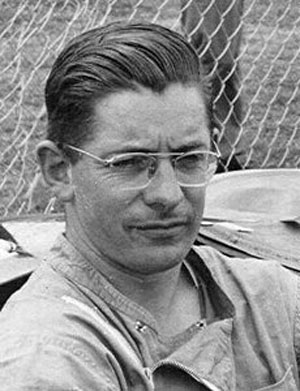Paul England (28 March 1929 – 17 June 2014) was an Australian former racing driver. He worked for the Repco company and raced his own 138 Holden-powered grey motor Ausca sports racing car that used a fiberglass body based on the A6GCS Maserati. The AUSCA also won the Tom Sulman Trophy at Amaroo Park in 1980 by new owner and driver Bruce Polain having restored the car with the assistance of Dave Mawer.
England contested a single Formula One World Championship Grand Prix race, the 1957 German Grand Prix, in a Formula Two Cooper T41-Climax. He retired from the race due to a fault with the distributor. After his return from Europe, England used a car by the same name Ausca but was a totally different creation – an 1800cc VW in front and a 2200cc VW in back both supercharged by the one supercharger with a special manifold to take the compressed intake to the other end, to win three Australian Hillclimb Championships, in 1970, 1973 and 1974.
After retiring from racing, England owned a general engineering company called Paul England & Staff in Essendon, Victoria, Australia. Paul England & Staff is run by his first child and eldest daughter, Lisa Mary Coulton and her husband Steven Coulton. Paul had nine grandchildren.
In the 1970s England’s company built 1.6 litre Ford engines for motor racing which were referred to as an England engine. Info from Wiki
Australian driver who made racing cars back home and contested the German Grand Prix in 1957 in a Cooper Climax. Later ran an engine balancing business.
Born in Melbourne, Victoria, Australia, Paul England was a well regarded engineer in Australian racing scene. He worked at Repco in the mid 1950s and built a sports car called the Ausca. Powered by a Holden six-cylinder engine with a Repco head designed by Phil Irving, who designed the 1966 Repco V8 F1 engine, the body was modelled on the Maserati A6GCS.
Paul went to Europe in 1957 and aquired a Cooper T41 Climax for a motor racing holiday. He competed in a number of Formula 2 races as well as the German Grand Prix. On July 6th, entered under the Colonial Equipe banner, he came 8th in both heats and 8th overall in the BRSCC F2 race at Mallory Park. Eight days later he was at Reims for the Coupe Internationale de Vitesse finnishing 8th again.
He then went to the German GP on August 8th entered by Ridgeway Managements in the F2-class, but failed to finish. He was also entered for the International Trophy on September 14th, but failed to appear.
Back in Australia he concentrated on hill climbs but did enter occasional road races.He appeared three times in the Bathurst race held at the time on the circuit at Phillip Island. In 1960, driving an NSU Prinz with Bruce Walton they finished second in class, and 26th overall. The following year he shared a Triumph Herald with Hoot Gibson but they were disqualified for receiving illegal help from a mechanic. In 1962 Gibson, England and Jack Madden drove a Herald to seventh in class and 19th overall.
He built another Ausca, this time a twin engined VW hillclimb special. The car featuring a VW flat four at each end, each one driving its own pair of wheels.
The front engine was 1800cc and also drove a supercharger that fed both engines, the rear engine was approximately 2200cc. He won the Australian Hillclimb Championship in 1970, 1973 and 1974.
After leaving Repco in the late 1950s he started his own engine balancing business, called Paul England & Staff in Essendon, Victoria, Australia. Paul England and Staff is run by his 2nd child and eldest son, Anthony Paul Thomas England.

Gallery Other



